Crime in Mexico
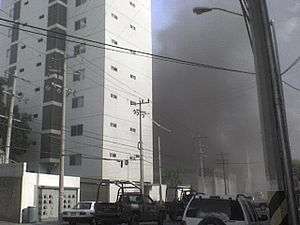
Crime is among the most urgent concerns facing Mexico, as Mexican drug trafficking rings play a major role in the flow of cocaine, heroin, and marijuana transiting between Latin America and the United States. Drug trafficking has led to corruption, which has had a deleterious effect on Mexico's Federal Representative Republic. Drug trafficking and organized crime have also been a major source of violent crime in Mexico.
Mexico has experienced increasingly high crime rates, especially in major urban centers. The country's great economic polarization has stimulated criminal activity mainly in the lower socioeconomic strata, which include the majority of the country's population. Crime continues at high levels, and is repeatedly marked by violence, especially in the cities of Tijuana and Ciudad Juárez, and the states of Baja California, Durango, Sinaloa, Guerrero, Chihuahua, Michoacán, Tamaulipas, and Nuevo León.[1] Other metropolitan areas have lower, yet still serious, levels of crime. Low apprehension and conviction rates contribute to the high crime rate. Since many crimes go unreported, the rates may be much higher than reported by the government.[2] The murder rate in 2015 was 14 per 100,000.[3] Most of the crime is committed by a small proportion of the population involved in the drug trade with about half of murders drug related.[4]
Assault and theft make up the vast majority of crimes. While urban areas tend to have higher crime rates, as is typical in most countries, the United States–Mexico border has also been a problematic area. In 2017, Mexico witnessed a record number of murders with 29,158 homicides recorded.[5]
Mexico is Latin America's most dangerous country for journalists according to the Global Criminality Index 2016. A large number of these crimes go unpunished, which has led to campaigns in the press and demonstrations highlighting the supposed 'impunity' of those responsible for murdering investigative journalists.[6]
| Crime rates in Mexico per 100,000 inhabitants | |||||||
|---|---|---|---|---|---|---|---|
| 2000 | 2001 | 2002 | 2003 | 2004 | 2005 | USA in 2004 | |
| Total Crimes | 1433.81 | 1439.41 | 1391.54 | 1521.93 | 1503.71 | 1,425.98 | 4118.76 |
| Murder | 14.93 | 15.13 | 14.11 | 13.94 | 13.04 | 10.91 | 5.62 |
| Murder with firearm | 3.45 | 4.54 | 3.66 | 3.53 | 2.58 | 3.08 | 3.12 |
| Assault | 254.35 | 257.39 | 260.39 | 260.41 | 251.91 | 224.17 | NA |
| Aggravated assault | 171.06 | 172.02 | 185.01 | 187.33 | 186.68 | 162.85 | 310.14 |
| Rape | 11.89 | 11.9 | 13.33 | 13.05 | 14.26 | 12.86 | 32.99 |
| Theft | 148.27 | 108.11 | 100.22 | 116.74 | 112.47 | NA | 2445.80 |
| Automobile theft | 161.15 | 161.52 | 162.10 | 150.66 | 139.86 | 136.47 | 432.12 |
| Robbery | 316.54 | 274.63 | 219.59 | 158.16 | 146.57 | 489.96 | 145.87 |
| Burglary | 145.72 | 153.58 | 142.58 | NA | NA | 20.52 | 746.22 |
| Fraud | 54.63 | 50.48 | 50.96 | 54.64 | 61.47 | 53.67 | NA |
| Drug offenses | 20.62 | 23.97 | 24.65 | 23.38 | 23.40 | 37.31 | NA |
| Source: The 7th[7] and 8th,[8] 10th[9] Surveys, United Nations | |||||||
Crime by type
Murder
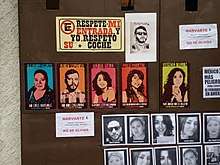
In 2012, Mexico had a murder rate of 21.5 per 100,000 population.[10] There were a total of 26,037 murders in Mexico in 2012.[10] Between 2000 and 2013, 215,000 people in Mexico were murdered. By 2013 there were only 30,800 people incarcerated for murder, showing that there is a large number of murders that go unsolved.[11] In October 2017, Mexico suffered its deadliest month since it started keeping such data in 1997, with 2,371 murder investigations.[12] 2017 was Mexico's deadliest year on record, with 31,174 murders recorded, leading to a murder rate of 25 per 100,000 inhabitants in 2017, compared with 19.4 in 2011. [13] In May 2018, Mexico broke the previous deadliest month on record set in October with 2,530 reported cases of intentional homicides during the month, or 93 per day. [14]
By states
The state of Chihuahua ranked number one with the most homicide in the country, the least was Baja California Sur.
Drug trafficking
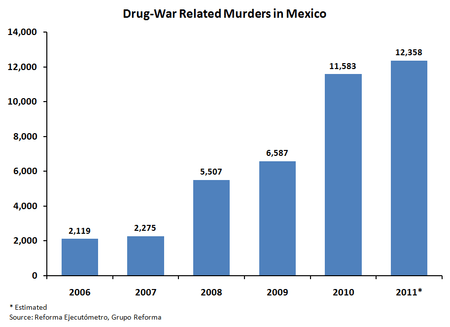
The United States is a lucrative market for illegal drugs. The United Nations estimates that nearly 90% of cocaine sold in the United States originates in South America and is smuggled through Mexico.[15] Mexico is the largest foreign supplier of marijuana and the largest source of heroin for the U.S. market. The majority of methamphetamine sold in the United States is made in Mexico, and Mexican-run methamphetamine labs that operate north of the border account for much of the remainder.
Drug cartels
Mexican drug cartels play a major role in the flow of cocaine, heroin, and marijuana transiting between Latin America and the United States. These drug cartels often use Mexican-American and other Latino gangs to distribute their narcotics in United States.
Mexican drug cartels also have ties to Colombian drug traffickers, and other international organized crime. A sharp spike in drug-related violence has some analysts worrying about the 'Colombianization' of Mexico.[16]
Domestic production of illegal drugs
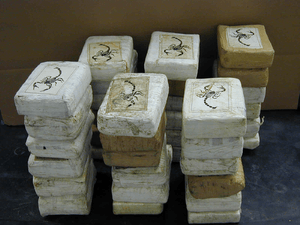
Some illegal drugs are also produced in Mexico, including significant amounts of opium poppy, and marijuana in the western Sierra Madre Mountains region.[17] Mexico has increasingly become a major producer of amphetamines and other synthetic drugs in the North American market (e.g. crystal), especially in the states of Guerrero, Michoacán, Jalisco and the Distrito Federal.[17] Since early 2007, the export of manufactured drugs has been controlled by the Beltran-Leyva brothers (Sonora-Sinaloa-DF) and "la Familia de Michoacán". These two crime groups have controlled the corridors from the deep sea port of Lázaro Cárdenas in Michoacán, where precursor products to manufacture synthetic drugs are imported from Asia.[18]
Domestic consumption of illegal drugs
Marijuana, crack cocaine, methamphetamine, and other drugs are increasingly consumed in Mexico, especially by youths in urban areas and northern parts of the country.[19]
Corruption
High levels of corruption in the police, judiciary, and government in general have contributed greatly to the crime problem. Corruption is a significant obstacle to Mexico's achieving a stable democracy.[20]
Mexico is ranked the 123rd least corrupt country in the world which makes them less corrupt than Moldova and more corrupt than Laos. This is according to the Corruption Perceptions Index, which is based on 13 different surveys and includes police, business, and political corruption.
Corruption in law enforcement
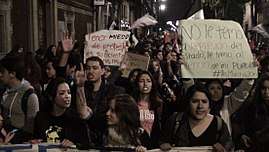
The organization of police forces in Mexico is complex; each police force has a different level of jurisdiction and authority, and those levels often overlap. The Procuraduría General de la República (Federal Attorney General's office) along with the law enforcement agencies Policia Federal Preventiva and Agencia Federal de Investigación, has responsibility for overseeing law enforcements across the entire country. In addition, there are several police organizations at the state, district, and city level. Since pay is generally poor (U.S.$285–$400 per month), police officers are more likely to accept bribes to protect criminals or ignore crime entirely.[21] Law enforcement personnel are often presented with the option of choosing "Plata o Plomo"; meaning they can either accept a bribe (plata, for silver) or they will be killed (plomo, for lead).
Corruption plagues the various levels of police, and is frequently difficult to track down and prosecute since police officers may be protected by district attorneys and other members of the judiciary. The problem is especially pronounced in northern border areas such as Tijuana, where police are engaged by drug traffickers to protect and enforce their illicit interests.[22]
The Mexican police force often do not investigate crimes, will generally randomly select someone to be the guilty party then fabricate the evidence.[23] This issue is a major problem throughout Mexico as many of the actual police force are the ones involved in the crimes or are trying to cover up their poor police work.[24]
Corruption in the judiciary
A United Nations Special Rapporteur undertook a mission to Mexico in 2002 to investigate reports by the United Nations Commission on Human Rights that the country's judiciary and administration of law was not independent.[25] During the course of his visit to a number of cities, the rapporteur observed that corruption in the judiciary had not been reduced significantly. One of the principal issues is that, because the federal courts operate at a relatively high level, most citizens are compelled to seek justice in the inadequate state courts.[25]
Additionally, the rapporteur expressed concerns about such issues as disorganization in the legal profession, difficulties and harassment faced by lawyers, poor trial procedures, poor access to the justice system for indigenous peoples and minors, and lacklustre investigation of many crimes.[25]
Violent crime against journalists

A significant increase in violent crime against journalists has been encountered in the country in recent years.[26] Although the problem has existed since at least 1970, the amount of violence against journalist has intensified since the beginning of the Mexican Drug War, with at least 90 journalists murdered or disappeared in Mexico since 2006.[27][28] Few of the perpetrators have been brought to justice. One of the more prominent cases was that of syndicated columnist Francisco Arratia Saldierna, a prominent and well-known journalist who wrote a column called Portavoz (or "Spokesman"). The column featured topics such as corruption, organized crime, and drug trafficking.[29]
Arratia's murder, which was particularly brutal, and others like it, sparked demands from other journalists that then-President Vicente Fox do more to enforce security and bring those responsible for the murders to justice. In 2004, a group of 215 reporters and editors sent an urgent letter to President Fox and other federal authorities, demanding that they address these concerns. The letter represented a massive communication effort coming from professionals from 19 of the nation's 31 states. The key demand was that violent crimes against journalists be made federal crimes, so they would be investigated and prosecuted by federal officers and not by local officials whom the letter claims could be the same people who commit the crimes.[29]
The effect of these crimes has been the self-censorship of many journalists, due to fears of retribution from criminals.[26] The situation has earned attention from prominent global organizations such as the office of the United Nations High Commissioner for Human Rights (OHCHR) and the Center for Journalism and Public Ethics (CEPET). Amerigo Incalcaterra of the OHCHR advocated the protection of journalists and the preservation of freedom of speech, calling it "essential for the consolidation of democracy and the rule of law in this country".[26]
Forced disappearance
.jpg)
Over 30,000 people in Mexico have been reported missing in 2016.[30]
Violence against women
As of 2014, Mexico has the 16th highest rate of homicides committed against women in the world.[31] This rate has been on the rise since 2007.[31]
According to the 2013 Human Rights Watch, many women do not seek out legal redress after being victims of domestic violence and sexual assault because "the severity of punishments for some sexual offenses contingent on the "chastity" of the victim" and "those who do report them are generally met with suspicion, apathy, and disrespect."[32]
According to a 1997 study by Kaja Finkler, domestic abuse "is embedded in gender and marital relations fostered in Mexican women's dependence on their spouses for subsistence and for self-esteem, sustained by ideologies of romantic love, by family structure and residential arrangements."[33]
In Mexico city, the area of Iztapalapa has the highest rates of rape, violence against women, and domestic violence in the capital.[34]
Gender violence is more prevalent in regions along the Mexico-US border and in areas of high drug trading activity and drug violence.[35] The phenomenon of the female homicides in Ciudad Juárez involves the violent deaths of hundreds of women and girls since 1993 in the northern Mexican region of Ciudad Juárez, Chihuahua, a border city across the Rio Grande from the U.S. city of El Paso, Texas. As of February 2005, the number of murdered women in Ciudad Juarez since 1993 is estimated to be more than 370.[36]
By location
Mexico City
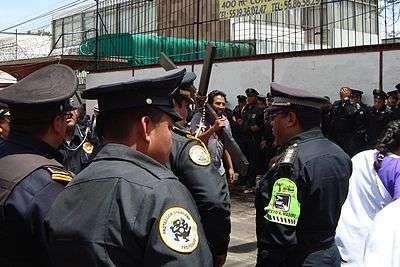
Between 2000 and 2004 an average of 478 crimes were reported each day in Mexico City. The actual crime rate is thought to be much higher "since most people are reluctant to report crime."[37] Under policies enacted by Mayor Marcelo Ebrard between 2009 and 2011, Mexico City underwent a major security upgrade with violent and petty crime rates both falling significantly despite the rise in violent crime in other parts of the country. Some of the policies enacted included the installation of 11,000 security cameras around the city and a very large expansion of the city police force.[38]
Mexico City currently has one of the highest police officer to resident ratios in the world, with one uniformed police officer per every 100 citizens.[38] The murder rate in 2009 was 8.4 per 100,000 — by comparison, higher than the 5.6 in New York City[39] but much less than the 14.8 in Atlanta.[40]
In Mexico City, the area of Iztapalapa has the highest rates of rape, violence against women, and domestic violence in the capital.[34]
Crime reporting and sentencing rate
According to the CNDH, only one out of every ten crimes is reported in Mexico; this is due to lack of trust from citizens to the authorities. Furthermore, only one out of 100 reported crimes actually goes to sentencing.[41]
Effects on tourism
A significant number of United States citizens visit Mexico; the U.S. State Department estimates it at 15 to 16 million per year.[42] Tourists visiting Mexico may face a number of problems related to criminal activity, including:
- Extortion by law enforcement and other officials.
- Kidnappings, particularly in northern border cities.
- Taxi robberies and armed robbery.
- Purse-snatching and pickpocketing.
Due to crime reaching a critical level in Mexico City and many other areas, tourism to Mexico has suffered.[43]
Recently, Verdugo-Yepes, Pedroni and Hu ([44]) applies a panel structural vector autoregression model to model the effects of crime on GDP growth and foreign direct investment (FDI) at the state and national level.
Efforts to combat crime
Law enforcement initiatives
Mexican law enforcement is divided between federal, state, and municipal entities. Estimates range between 1,600 and 3,000 different police forces in total. There are over 350,000 police agents in Mexico.
At all levels, policing in Mexico tends to maintain separate forces for patrol/response (preventive) policing on the one hand and investigative (judicial) policing on the other.
Federal forces at the border
In June 2005, the government deployed federal forces to three states to contain surging violence linked to organized crime. At a news conference in Mexico City, presidential spokesman Rubén Aguilar told reporters that the new deployment was the result of evidence that organized crime has penetrated some local police departments.[45]
Technology in Tijuana
In response to a rise in violent crime in the region of Tijuana, considered one of the five most violent areas of the country by the U.S. State Department, mayor Jorge Hank Rhon deployed a massive technology update to the city's police force in February 2006. The technology includes surveillance equipment, handheld computers, and alarm systems. Since tourism is a staple of the economy in Tijuana, the mayor has tried to make reforms to highlight the safety of tourist areas.Tijuana has installed a sophisticated public-security system that is the envy of police departments around the world, but city officials don't seem to know details about how it is funded or the background of the company that supplied it.[46]
Political initiatives
President Vicente Fox took power in December 2000 promising to crack down on crime and improve a judicial system rife with corruption and ineptitude. Upon taking office, he established a new ministry of Security and Police, doubled the pay for police officers, and committed to other ethics reforms.[47] President Fox also cited drug trafficking and drug consumption as the top cross-border priority issue.[47]
During the first three years of Fox's government, the official number of reported kidnappings showed a slight decrease, from 505 in 2001 to 438 in 2003. The new Federal Investigation Agency (Procuraduria de Justicia) reported dismantling 48 kidnapping rings and saving 419 victims.[48]
Cooperation with the United States
In 1996, Mexico changed its policy to allow extradition of its citizens to the United States to face trial.[49] Previously, the Constitution had forbidden its citizens to be extradited.
In 2005, the U.S. State Department defended efforts by the two countries to reduce violence and drug trafficking on the border following decisions by governors in the U.S. states of Arizona and New Mexico to declare an emergency in their border counties. The two governors stated that the federal government's inability to control crime and violence related to illegal immigration had forced them to take matters into their own hands. The Mexican government criticized the emergency declarations.[50]
The U.S. state of Texas and Mexican police officials held a conference in San Antonio to discuss ways of coordinating efforts to stop crime but there are questions about how successful the program will be.[51]
Many Mexican police officials in border towns have been targets of assassination by drug cartels, who have even threatened local law enforcement in the United States.[52] Drug cartels have even acquired equipment like Mexican Army uniforms, Humvees, grenades and .50 calibre sniper rifles which can penetrate most light armour including armoured cars. The United States ambassador launched a formal complaint with the government on this issue.
In January 2003, the security consulting company of former New York City Mayor Rudolph Giuliani was hired by business leaders to come up with a plan to clean up Mexico City, which has the second-highest crime rate in Latin America.[53] If such a plan was developed, it was either not implemented or not effective. Further information about the plan was not provided by the government nor Giuliani.
Social initiatives
Protest march against crime
.jpg)
In June 2004, at least a million people marched through the Mexican capital and other cities to protest the failure of federal and local governments to control crime in one of the world's most crime-ridden countries.[54]
In 2008, a second civilian protest was made after independent NGOs exhorted the public, again, at least one million people attended over Mexico City and other major cities all across Mexico. On this second march candles were lit and the national anthem was played. The protest generated more public attention perhaps because in this same year, a 12-year-old son of the Marti family, owners of a prominent well-known sports gear business, was abducted and murdered. In the same year, a similar situation occurred to the 19-year-old daughter of Nelson Vargas, a businessman and former government representative. These two cases brought great public attention since the scale of crime and violence was very rare to hit over certain social groups, being these amongst the most remarkable exemptions.
Human rights violations
In its effort to combat crime, the Mexican army was accused of crimes against of humanity by several NGOs. In September 2014, several Mexican human rights groups and International Federation for Human Rights, had filed a complaint with the office of the prosecutor of the International Criminal Court, asking it to investigate the “systematic and widespread” abuse of thousands of civilians by the army and the police in their fight against organized crime.[55]
See also
- Gun politics in Mexico
- International child abduction in Mexico
- Presumed Guilty, a 2009 Mexican documentary film
References
- ↑ "El narco se expande en México". New America Media. Archived from the original on November 25, 2011. Retrieved 7 October 2011.
- ↑ "Mexico City crime rate rises sharply". AP/Lubbock Avalanche-Journal. December 15, 1997. Archived from the original on 2006-03-23. Retrieved 2006-05-23.
- ↑ Montes, Juan (22 January 2016). "Murders Jumped 8.7% in Mexico in 2015; First Increase Since 2011". Wsj.com. Retrieved 17 July 2017.
- ↑ "The Staggering Death Toll of Mexico's Drug War". Pbs.org. Retrieved 17 July 2017.
- ↑ Is Cancun Safe? 14 Killed in Brutal Crime Spree at Mexican Resort Town Brendan Cole, Newsweek, April 13, 2018
- ↑ "Reporter's Murder in Mexico Revives Outrage over Violence against Journalists". leakofnations.com. Retrieved 2017-03-27.
- ↑ "The Seventh United Nations Survey on Crime Trends and the Operations of Criminal Justice Systems (1998–2000)". Unodc.org. Retrieved 16 October 2017.
- ↑ "The Eighth United Nations Survey on Crime Trends and the Operations of .Criminal Justice Systems (2001–2002)". Unodc.org. Retrieved 16 October 2017.
- ↑ "The Tenth United Nations Survey of Crime Trends and Operations of Criminal Justice Systems (Tenth CTS, 2005–2006)". Unodc.org. Retrieved 2015-11-23.
- 1 2 "UNODC: Global Study on Homicide". Unodc.org. Retrieved 17 July 2017.
- ↑ "Mexico's president appears to be fudging numbers about the biggest threat to the country". Uk.businessinsider.com. Retrieved 17 July 2017.
- ↑ "Mexico suffers deadliest month on record, 2017 set to be worst year". Reuters.com. Retrieved 23 November 2017.
- ↑ "Mexico had more homicides in 2017 than previously thought". ABC News. Retrieved 31 July 2018.
- ↑ "Another record month: May homicide numbers worst ever seen". Mexico News Daily. Retrieved 28 June 2018.
- ↑ Cook, Colleen W., ed. (October 16, 2007). "Mexico's Drug Cartels" (PDF). CRS Report for Congress. Congressional Research Service. p. 9.
- ↑ Contreras, Joseph. "Losing the Battle: A sharp spike in drug-related violence has some analysts worrying about the 'Colombianization' of Mexico". Newsweek International.
- 1 2 "WORLD DRUG REPORT 2009" (PDF). Unodc.org. Retrieved 16 October 2017.
- ↑ Leticia Díaz, Gloria. 2009. "Estado de Mexico: Nuevo Domnio de "la Familia"." Pp. 30–33 in Proceso Edición Especial #25. Mexico City, D.F.: Proceso: semanario de Información y analisis General editor: Rafael Rodriguez Castaneda.
- ↑ Instituto Nacional de Estadística; Geografía e Informática (2002). Encuesta Nacional de Adicciones 2002 (PDF).
- ↑ Bailey, John (2000–2002). "The Mexico Project". Center for Latin American Studies, Georgetown University. Archived from the original on 2006-09-01. Retrieved 2006-06-05.
- ↑ "Mexico Police and Law Enforcement Organizations". Photius.
- ↑ "Police Drug Corruption". Drugwar.com. Archived from the original on 2013-10-30.
- ↑ Thompson, Ginger (September 26, 2005). "In Mexico's Murders, Fury Is Aimed at Officials". New York Times.
- ↑ "Mexico Police Torture persists". Reuters News Alerts. Archived from the original on 2015-10-03.
- 1 2 3 "Civil and Political Rights: Independence of the Judiciary, Administration of Justice, and Impunity" (PDF). U.N. Commission on Human Rights. Archived from the original (PDF) on 2008-10-03.
- 1 2 3 Cevallos, Diego (2006-05-02). "WORLD PRESS FREEDOM DAY-MEXICO: 5 YEARS, 15 JOURNALISTS KILLED". IPS – Inter Press Service/Global Information Network.
- ↑ "Press Freedom Online". cpj.org. Retrieved 2018-01-23.
- ↑ "Number Of Journalists Killed In Mexico Reaches 'Historical High,' Report Says". NPR.org. Retrieved 2018-01-23.
- 1 2 Hayward, Susana (2004-09-07). "Mexican journalists seek justice in deaths of colleagues". Knight Ridder/Tribune News Service.
- ↑ "Number of missing people in Mexico rises to 30,000 by end-2016". Reuters. 6 April 2017.
- 1 2 "Femicide and Impunity in Mexico: A context of structural and generalized violence" (PDF). 2.ohchr.org. Retrieved 12 March 2014.
- ↑ Human Rights Watch. "World Report 2013: Mexico". Retrieved 6 April 2014.
- ↑ Finkler, Kaja (1997). "Gender, domestic violence and sickness in Mexico". Social Science & Medicine. 45 (8): 1147–1160. doi:10.1016/s0277-9536(97)00023-3.
- 1 2 3 Ríos, Fernando (October 8, 2010). "Tiene Iztapalapa el más alto índice de violencia hacia las mujeres" [Iztapalapa has the highest rate of violence against women]. El Sol de México (in Spanish). Mexico City. Retrieved March 3, 2011.
- ↑ Wright, Melissa W. (March 2011). "Necropolitics, Narcopolitics, and Femicide: Gendered Violence on the Mexico-U.S. Border". Signs. 36 (3): 707–731. doi:10.1086/657496. JSTOR 10.1086/657496.
- ↑ "Mexico: Justice fails in Ciudad Juarez and the city of Chihuahua". Amnesty International. Archived from the original on 3 March 2012. Retrieved 19 March 2012.
- ↑ Reuters (May 12, 2004). "Police say Giuliani helps cut Mexico City crime". San Diego Union-Tribune. Archived from the original on June 9, 2004. Retrieved September 15, 2009.
- 1 2 JIMENEZ, MARINA (1 July 2011). "Security central in Mexico City's makeover". The Globe and Mail. Retrieved 17 July 2017.
- ↑ Where are world's deadliest major cities?, The Guardian, Nov. 30, 2012
- ↑ Atlanta Crime Stats, 2002–2010 Archived 2015-02-27 at the Wayback Machine., Atlanta Police Foundation
- ↑ Liliana Alcántara (December 15th, 2008) CNDH ve impunidad en 99% de delitos, El Universal, Retrieved February 11th, 2009
- ↑ Preston, Julia (May 1, 1998). "State Department Warns of 'Critical Levels' of Crime in Mexico". The New York Times.
- ↑ "Tips for Travelers to Mexico". U.S. Department of State.
- ↑ Concepcion Verdugo-Yepes; Peter Pedroni; Xingwei Hu (2015). "Crime and the Economy in Mexican States : Heterogeneous Panel Estimates (1993–2012)". IMF Working Paper 15/121.
- ↑ "Mexico deploys federal forces against organized crime along border". KRISTV.COM. June 13, 2005.
- ↑ "A $15.5M Surveillance System for Tijuana, But Who Paid for It?". SecurityInfoWatch.com. Retrieved 2015-11-23.
- 1 2 Sánchez, Marcela – host (February 15, 2001). "Leaders of the Americas, Live online chat with Mexican President Vicente Fox". The Washington Post.
- ↑ "Demonstrations against crime surge spread all over Latin America". Pravda. June 24, 2004.
- ↑ LaGesse, David (March 29, 1996). "Mexico to allow extradition to U.S.". The Press Enterprise (Riverside, Ca.).
- ↑ Talhelm, Jennifer. "State Department defends U.S. and Mexico crime-fighting on border". San Diego Union-Tribune. Archived from the original on 2005-12-19.
- ↑ "Texas Attorney General – Press release archives". Oag.state.tx.us. Retrieved 16 October 2017.
- ↑ "Murder money & Mexico". Pbs.org. Retrieved 16 October 2017.
- ↑ "Giuliani targets Mexico crime wave". BBC. January 14, 2003.
- ↑ "Huge march against crime wave". China Daily. June 28, 2004.
- ↑ "Mexican Rights Groups File Suit for 'Systematic and Widespread' Abuse by Army and Police". The New York Times. 12 September 2014.
Other references
- "A Country Study: Mexico". The Library of Congress Country Studies. Retrieved 2006-06-05.
- Dibble, Sandra (2006-02-16). "Serious about safety; Tijuana takes high-tech road to combat crime". The San Diego Union-Tribune.
- "Mexico". CIA World Factbook. Retrieved 2006-06-05.
- "Project on Reforming the Administration of Justice in Mexico". Center for U.S. – Mexican Studies, University of California, San Diego. Archived from the original on 2010-06-17. Retrieved 2009-06-11.
- Vilalta, C. (2010). "The spatial dynamics and socioeconomic correlates of drug arrests in Mexico city" (PDF). Applied Geography, 30(2), pp. 263–270.
- Vilalta, C. (2011). "Monthly patterns, trends, and trajectories in the count of deaths related to organized crime, 2006–2010" (PDF). Conference at UAEM (in Spanish), April 26, 2011. Archived from the original (PDF) on August 17, 2011.
External links
| Wikimedia Commons has media related to Crime in Mexico. |
- Mexico Black Markets Havocscope Black Markets
- Mexico: An Embattled Country from the Dean Peter Krogh Foreign Affairs Digital Archives
- Mexico page on InSight Crime Ongoing reporting on Mexico's drug war and involved cartels.
- Mexican Crime Stats NationMaster
- Mexican Crime Statistics and Analysis Center for Economic Research and Education (CIDE)
- Organized Crime and Terrorist Activity in Mexico, 1999–2002 Library of Congress
- Potent Mexican Meth Floods In as States Curb Domestic Variety New York Times
- The Best Page about Mexican Crime Statistics Actualized to 2011 in some cases
.svg.png)